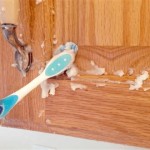How to Sand and Stain Kitchen Cabinets
Kitchen cabinets are a focal point of any kitchen, and their finish can make a big difference in the overall look and feel of the space. If your cabinets are looking tired and dated, sanding and staining them is a great way to give them a fresh new look.
Sanding and staining kitchen cabinets is a relatively simple process, but it does require some time and effort. The most important thing is to prepare the cabinets properly and to use the right materials. With a little care and attention, you can achieve professional-looking results.
Materials You'll Need:
* Sandpaper in various grits (80, 120, 150, 220) * Sanding block or orbital sander * Tack cloth * Stain of your choice * Foam brush or staining pad * Polyurethane finish * Brush or rollerStep 1: Prepare the Cabinets
* Remove all hardware from the cabinets. * Clean the cabinets thoroughly with a degreaser to remove any dirt or grease. * Allow the cabinets to dry completely.Step 2: Sand the Cabinets
* Starting with 80-grit sandpaper, sand the cabinets in the direction of the grain. * Use a sanding block or orbital sander to achieve a smooth, even surface. * Gradually move up to finer grits of sandpaper (120, 150, and 220) to smooth out any scratches.Step 3: Clean the Cabinets
* Wipe down the cabinets with a tack cloth to remove any sanding dust. * Allow the cabinets to dry completely.Step 4: Apply Stain
* Stir the stain thoroughly before applying it. * Apply the stain evenly to the cabinets with a foam brush or staining pad. * Work in small sections, and apply the stain in the direction of the grain. * Allow the stain to penetrate the wood for 5-10 minutes before wiping off any excess.Step 5: Apply Polyurethane Finish
* Apply polyurethane finish to the cabinets with a brush or roller. * Apply several thin coats, allowing each coat to dry completely before applying the next. * Sand lightly between coats with 220-grit sandpaper to remove any raised grain.Step 6: Reattach the Hardware
* Once the finish is completely dry, reattach the hardware to the cabinets.Tips for Success:
* Use a sanding block or orbital sander to achieve a smooth, even finish. * Sand in the direction of the grain to avoid creating scratches. * Clean the cabinets thoroughly before sanding or staining to remove any dirt or grease. * Allow the stain and polyurethane finish to dry completely before reattaching the hardware. * If you are unsure about any step of the process, consult with a professional.
Staining Your Wood Cabinets Darker Young House Love

How To Make Rustic Kitchen Cabinets By Refinishing Them The Best Stain Color Amanda Katherine

Refinishing Kitchen Cabinets Modern Refacing Made Easy Wisewood

Refinish Kitchen Cabinets Without Stripping

How To Refinish Wood Cabinets The Easy Way Love Remodeled

How To Stain Oak Cabinetry Tutorial The Kim Six Fix
Refinishing Kitchen Cabinets A Beautiful Mess

How To Refinish Wood Cabinets The Easy Way Love Remodeled

Diy Staining Oak Cabinets Eclectic Spark

How To Make Rustic Kitchen Cabinets By Refinishing Them The Best Stain Color Amanda Katherine
Related Posts








